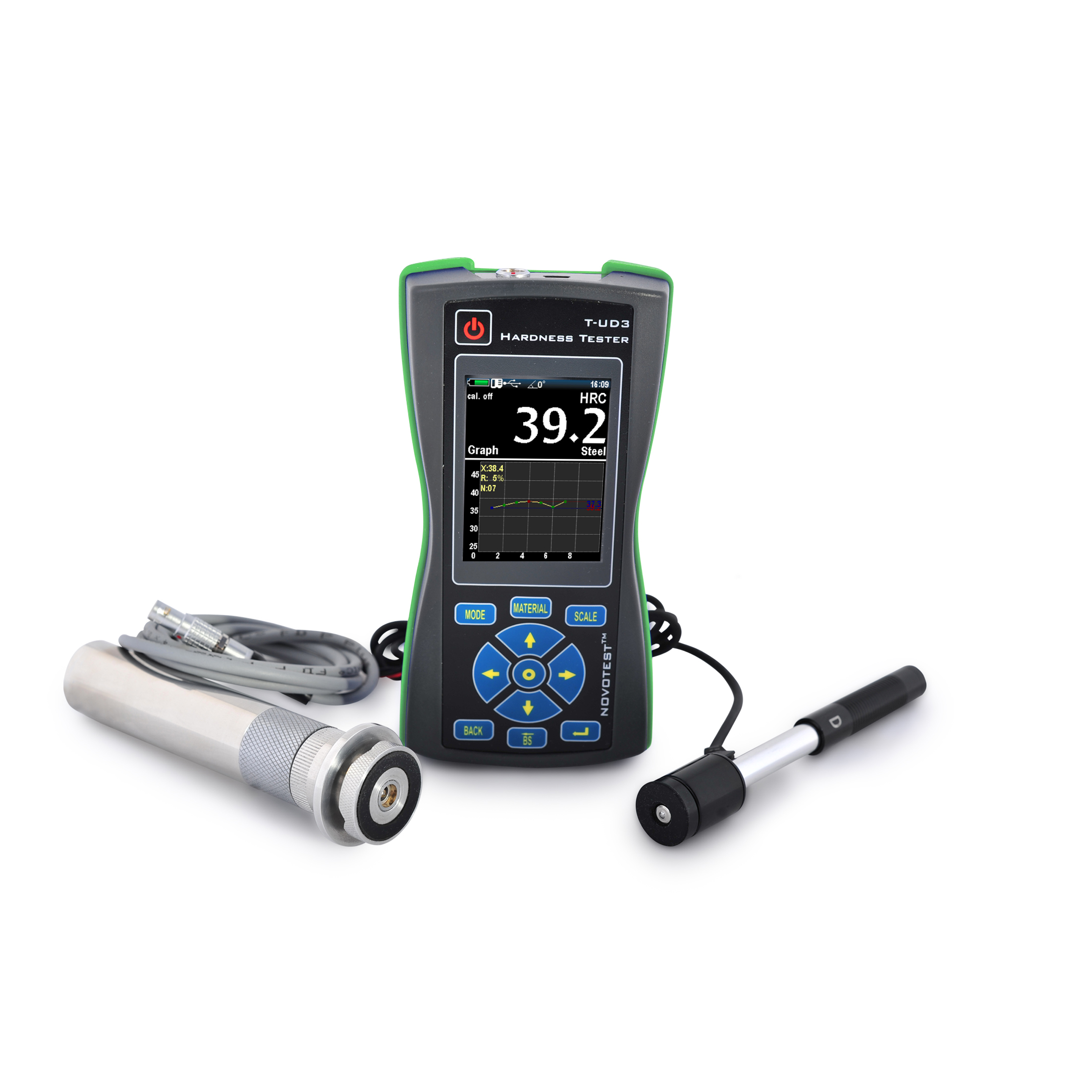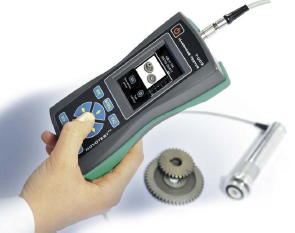products
Hardness Testers
Combined Hardness Tester NOVOTEST T-UD3
 |
Unique, multi-functional, convenient, and reliable tester at affordable price. Hardness tester has technical specifications that are similar or superior to the most expensive commercially available hardness testers, with a much wider functionality:
|

|
Built-in camera allows to take a picture of tested object and mark tested area with corresponding hardness value. User get the most reliable and intuitive method of logging of measurements.
The device operates with both UCI (Ultrasonic Contact Impedance) and Leeb (dynamic) probes. User get the benefits of two methods of measurement.
|
UCI method for the hardness testing
The ultrasonic contact impedance (UCI) probe is used for measuring the hardness of small items, objects with a thin wall, complex form, and to measure the hardness of surface hardened layers.
Universal portable hardness tester T-UD3 use the UCI method for the hardness measuring, which is standardized according to ASTM A 1038. This method allows user to measure very fast and easy: install the probe on tested object, press on the probe with required effort and after that save the results of the hardness value, which are showed on the display of the device. Diamond indenter has a small size that allows user to measure hardness value of all samples, which are thicker than 1 mm. The UCI method of hardness testing is the least destructive method because the hardness tester T-UD3 leaves much smaller stamps than leaves the bench hardness tester. That’s why portable hardness tester T-UD3 is very useful and universal.
Leeb method for the hardness testing
Leeb probe is used for measuring the hardness of non-ferrous metals, cast iron, coarse-grained materials, massive products etc.
Hardness tester T-UD3 also use a dynamic method of the hardness measuring – Leeb method, which is standardized according to ASTM A596. This method allows user to measure very fast and easy: install the probe, press on the probe to recharge spring, press the button on the top of the probe to make test and after that save the results of the hardness value, which are showed on the display of the device. This method is used for measuring the hardness value of non-ferrous metals, cast iron, coarse-grained materials, massive products etc. (with weigh more than 5 kg or thicker than 10 mm) also this method perfectly complements the UCI method of hardness measuring.
Hardness tester T-UD3 makes automatic calculation of the hardness for wide range of materials: steel, stainless steel, cast iron, bronze, aluminum, so that we can say that combined hardness testers is the most universal, which is needn’t in recalibration, and fully ready for operation after “getting out of the box”. During the hardness testing, user can take a picture of the sample and print the results of hardness measurements on some place on the photo of sample. Saved results of measurements in the device can be transmitted to a PC for creating a report of testing in a specialized program – “ARM”, which supplied with the hardness tester.
Hardness tester allows user to measure the hardness at extremely low temperatures. The real tests has been carried out at a temperature of 25°C below zero. The device is operated very easily, the measurement accuracy did not exceed the value according to standards, keyboard and display of the device allowed user to operate confidently. The difference between the operating at the indoor temperature and operating at the extreme cold (-25°C) is not noticeable.
Advantages
Small imprint after measuring (mirror surfaces of shafts necks, blades, gear teeth, etc.)
Measuring the hardness of the surface hardened layer
Wide range of hardness testing
Various measurement modes
88 combinations of materials and hardness scales (calibrations)
Calibration of any scale in any range
Convenience and ease of measurement
Optimized number of buttons
Large full color graphic display with bright backlighting
Photofixing of measuring samples
Automatic recognition of probe
Indication of the type of connected probe
Calibrations stored in memory of UCI probe
Extended temperature range (frost, down to – 40°C)
Internal memory and communication with PC
New intuitive menu with tips on the buttons
Optional wireless mini printer
Water resistant case
Rubber bumper protected case
Internal clock
Measure hardness value of any mass products with a thickness more than 1 mm (small parts, thin-walled structures, pipes, tanks, steel sheets, articles of complex shape, hardness testing of metal coatings, etc.)
The device has different operating modes:
Graph – the mode of building of graph
Histogram – the mode of building of histogram
Statistics – the mode of statistic
Smart – the mode of filtering of incorrect measurements
Signal – the mode of displaying of signal (only for Leeb probe)
Specifications
UCI probe types 1kgf (10N) 2.2 lbf, 5kgf (50N) 11lbf, 10kgf (98N) 22lbf
Leeb probe types D, DC, DL, C, D+15, E, G
Measuring range HV:230~940; HRC:20~70; HB:90~650. Tensile strength, MPa 370~1740
Measuring accuracy HV:±3%HV; HRC:±1.5%HRC; HB:±3%HB
Indenter Diamond indenter (UCI), Hardened ball (Leeb)
Measuring direction Any direction 360°
Data storage Limited only by the memory card
Communication Upload data to PC and export as a spreadsheet (USB cable and software included )
Hardness scale HRC, HB, HV, HRB, HS, HL, MPa
Materials
Ultrasonic (UCI) probe – pre-calibrated for steel.
Dynamic (Leeb) pre-calibrated for steel, alloy steel, cast iron, stainless steel, aluminum, bronze, brass, copper.
Additional custom materials for calibration.
Data display Load applied/contact (UCI), Angle (Leeb), Single test result, Max, Min, Average of tests, Number of tests, Deviation, Var. coeff, Histogram, Signal and Smart Mode (Filter of incorrect measurements).
Indication Color LCD display (320×240)
Operating environment Temperature:-20°C~40°C; Humidity: 30%~80%R.H.
Power supply DC 4,5V (3 pcs batteries AA)
Instrument dimensions 160x75x30mm
Net weight Approx. 0.3kg (without probe)
Battery life Approx. 10 hours.
Available options
Different colors of rubber bumper protected case
Wireless printer
Batteries
Chargers
Hardness tests blocks
Portable grinding machine
Case for hardness tester
Can be equipped with two types of UCI probes:
50N (11.2lbf) Considered to be the Universal type for most general applications.
50N of downward hand pressure is required to activate the probe.
Surface finish equivalent to 80 grind or better. Induction or carburized machined parts, e.g.. camshafts, turbines, weld inspection, HAZ.
Measurement in grooves, gear tooth flanks and roots
Turbine blades, inside tubes with ∅> 90mm.
10N (2.2lbf) Load is easy to apply; provides control to test on a sharp radius.
Only 10N of downward hand pressure is required to activate the probe.
Surface finish equivalent to 150 grind or better. Ion-nitrided stamping dies and molds, forms, presses, thin-walled parts
Bearings, tooth flanks
Turbine blades, inside tubes with∅> 90 mm.
Standard package
Hardness tester
UCI probe
Leeb probe
3 batteries
Charger
USB cable
Operating manual
Software for PC
Case
Media
Combined Hardness Tester NOVOTEST T-UD3. Video review
Correct UCI probe use for accurate results. UCI Hardness Tester NOVOTEST T-U3 (T-UD3)
Calibration UCI probe of Combined Hardness Tester T-UD3





